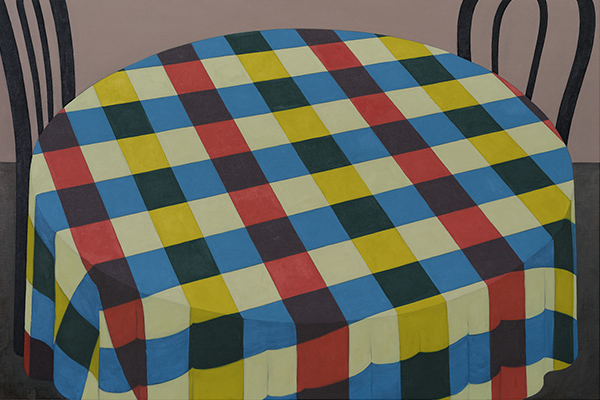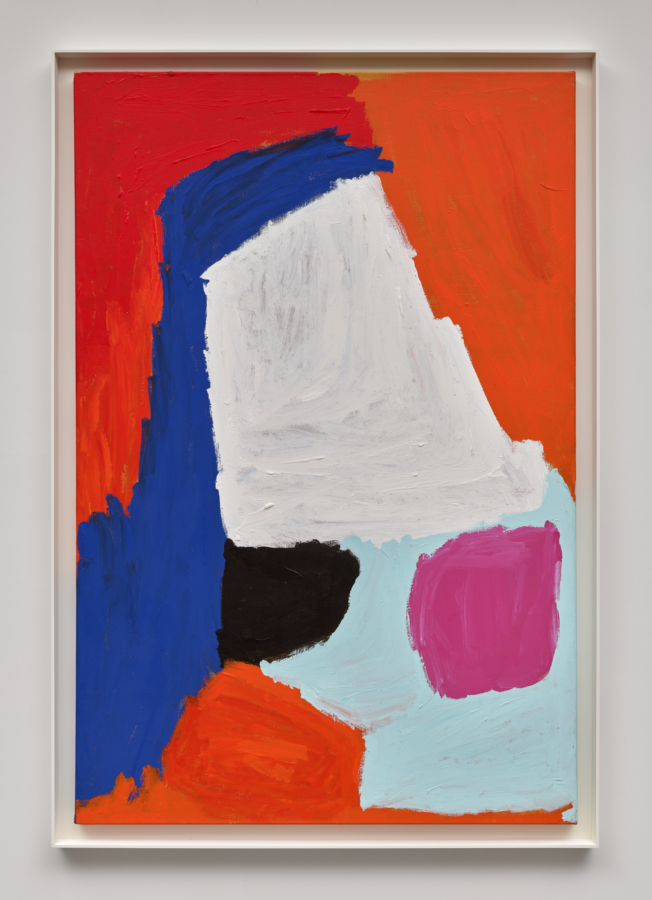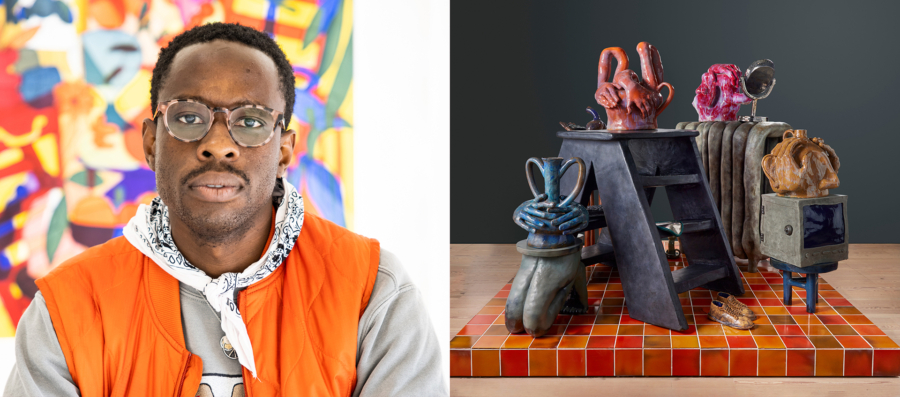December 2021
Woody De Othello, published by Karma/Jessica Silverman, New York, 2021
We live in uncanny times. According to Sigmund Freud, the uncanny is that which unsettles us by seeming familiar and yet strange—the disorientation of normal footholds when presented with something subconsciously known but repressed. European Surrealists of the interwar years turned to the uncanny as a way of accessing dream worlds beyond reality. Today in 2020, as the COVID-19 pandemic swells, shelter-in-place orders have confined people to their homes, driving record-breaking unemployment, while high-profile killings of Black Americans by police have catalyzed mass protests around the world. For some, this economic precarity and awareness of pervasive racial injustice is novel: an anxiety-inducing deviation from the familiar. But for others, this uncanny moment is the rising of the repressed, as the racial and economic inequalities that underlie America’s foundation finally enter widespread public consciousness. We are living in uncanny times.
Woody De Othello’s artwork emerges from a present haunted by centuries of racial oppression. To be Black in America, as Othello is, is to exist in a continuous, historic struggle to belong and to live. The term uncanny in German is unheimlich, literally unhomely: a linguistic acknowledgment that home is both the ultimate familiar, and the most acutely felt site of discomfort. Over the past four years, Othello’s developing ceramic practice has dwelt on the fixtures of domestic space through a particular idiom of unstable household objects: wobbly air conditioners, rotary telephones, clocks, padlocks, houseplants, remote controls, and curiously emotive vessels. His boldly colored anthropomorphic forms, displayed both alone and gathered in vignettes, posture and gesticulate expressively. A prevalence of large ears, lips, and noses (but not eyes) emerge from large, piled forms that droop and sag with corpulent weight. There is an element of humor—a lapping typewriter (Oration, 2018), hopelessly twisted faucet companions (Opposite Ends, 2020)—but any levity is tempered by the unease engendered by inscrutable companion forms, deflated and turned inward.
For Othello, humor functions like his works’ bright, shiny glazes: a tactical distraction that perfunctorily masks the unsettled forms populating his domestic dreamland. Among recognizable objects, Othello seems to favor mechanisms of control: light switches, faucets, fans, heaters, television remotes, thermostats, locks, and doors—the tools by which the American middle class regulates its domestic environments. Home is a fortress, protected and safe from outside forces. But is it? Othello’s work reveals the inherent strain of this notion: a remote control collapses against a wall (No Control, Remote Control, 2017); a space heater doubles over (with pain? fatigue?) (The Real Down and Out, 2018); a padlock-cum-purse restrains a hand beneath it (The Beholder, 2018); a menacing frown lurks behind a wall vent (In the Shadows, 2019). Othello’s domestic scenes are unstable, and by extension, unsafe. Rooted in his own identification with the diasporic search for belonging, Othello’s sculptures reflect a fraught notion of home: one shaped and impacted by economic pressures and persistent racism that padlocks and air conditioners cannot keep at bay. Yet despite the obstacles, the artist keeps making, dreaming, and working to create a space for himself in this world.
Othello’s practice is beholden to clay. Attracted to the ceramics program at the California College of the Arts in San Francisco, in 2015 Othello moved to the Bay Area, where he acknowledges absorbing much from the discourses around ceramics spurred by the legacies of artists Peter Voulkos, Robert Arneson, Viola Frey, Ron Nagle, and others. However, for Othello the connection to clay runs deeper. He recalled his first encounter with the material during college as a moment of revelation, of finding home: “I remember having this overwhelming feeling that everything I needed to know about my past and future was beholden to clay,” he says, describing a deep sense of connection, a spiritual transmission of knowledge through the earthen material. Though Othello’s parents emigrated from Haiti, he grew up in Florida steeped in African American culture. It was this discovery of clay as a visceral conduit that prompted exploration of his African ancestry, a heritage rich with ceramic practices.
Sensitive not only to impression but also to temperature, humidity, and motion, Othello describes clay as a “humbling” material: a relative sponge that absorbs and holds external pressures. Such receptive physical properties have psychic resonance with African objects known as nkisi, loosely translated as spirit but referring to an object or container that the spirit inhabits. Used by Othello’s ancestral Yoruba people, as well as others throughout the Congo basin, nkisi have the power to both contain and release spiritual forces in the physical world. “Part of me hopes that these objects I make can act as a type of sacrifice, a placeholder for all these negative emotions, so we don’t have to live with them in our own lives,” says the artist. A form of contemporary nkisi, Othello’s vessels and misshapen objects seem to react to and hold the energies of the space they inhabit, suggesting the power of pressures endured but not seen.
The artist’s process involves building up the clay form, slab by slab, until, burdened by its own heft, it slumps and folds. The soft structure is then left to harden—to reconcile itself to a new equilibrium—before the artist returns to apply more clay, further increasing the tensions of burden and resistance. The substantial mass (some sculptures weigh upward of sixty pounds) is then perched atop a rickety-looking ceramic stool or leggy end table. These solid, hardened clay objects seem to be on the verge of collapse: a fragility that bestows each piece with a psychological and emotional weight proportional to its physical heft. Glazes are sprayed on, rather than brushed, to prioritize a smooth finish—this maintains a polished finesse despite the threat of internal fissure, one might say. If a piece does not buckle under the stress or break in the kiln—and many do—then it survives. It’s a perverse sort of Darwinism.
Although Othello’s practice is more cathartic than academic (as external influences are filtered through the ambiguity of lived experience) he has drawn energy from theorists such as Caribbean psychiatrist Frantz Fanon—particularly Fanon’s recognition of the deep impact of racism on the Black psyche, a sustained trauma transmitted across generations to lasting effect. In Othello’s hands, the physical relationship between heft and gravity metaphorically expands to illustrate the weight of racial oppression compounded over centuries. The tension from this accumulation over time also figures representationally in Othello’s work. Among the lamps and vessels is a preponderance of exhausted clocks and silent telephones. As designed commodities, many are drawn from Othello’s own childhood, reflecting the styles of the 1990s: television sets with antennas, rotary and cordless telephones, an electric typewriter. However, the impulse for communication and the impatience they evoke—the clocks weary from tracking centuries of deferred justice, the writing and speaking implements limp from unheeded and unheard testimonies, the TVs tired from witnessing subjugation again and again—connects across generations. As time marches on, the injustices mount.
In four busy years since graduate school, Othello has created a personal body of work about navigating the self in context. Painting is a near daily practice for the artist—diaristic and self-reflective impulses that largely focus on the human figure. In works like Solitary Solidarity (2018), a seated figure grieves in a room with wood flooring and baseboard, head in hand. The clarity of the scene is startlingly direct, yet the figure’s oversize hands and unstructured feet lean toward the surreal: an initially familiar form vacillates in and beyond recognition. As Othello’s painted subjects take on sculptural form, the figure largely recedes into abstraction, but its introspection and psychological weight remain. In recent work Othello has incorporated water glasses and windows—objects with varying degrees of transparency—in response to postcolonial theorist Édouard Glissant’s concept of opacity, an aesthetic application of his “poetics of relation.” Glissant’s exploration of relational poetics articulates Caribbean identity as constructed through the parallel consciousness of self and surroundings. If transparency is valued by the colonizer for its accessibility, as that which can be understood within colonialist frameworks, then opacity is the right to claim difference, to exist beyond the limitations of colonial comprehension. In the painting This One Is a Little More Complicated (2019), a glass vase of flowers sits in juxtaposition with a compressed, fluidly limbed figure. Glissant posits transparency as oppressive, while opacity opens space for solitude, individuality, and the freedom of inscrutability.
Alternating between representation and abstraction, much of Othello’s work seems to dwell on an interiority indecipherable to the viewer. In the aptly titled Self Care (2017), an abstracted biological-seeming lump rests atop a small stool on a dainty green rug. The mass is furrowed and folded in on itself with occasional protruding openings, suggesting an interiority entirely protected from the public gaze. The dark vessel Defeated, depleted (2019) has a disorienting array of ears, protectively postured arms, and a grimly knotted neck hanging limp. Painted with layers of deep blue and black, the glossy surface and form seem designed to deflect comprehension. Some vessels are a jumble of sensory organs—hands, ears, and noses—reaching out vulnerably. While tools of communication like telephones, TVs, and typewriters suggest potential points of exchange, Othello’s versions of them embody a frustrated failing. Even the desire to communicate feels thwarted by failures both contemporary and historic, conjuring an ambivalence between one’s self and one’s surroundings. Every artwork is a self-portrait encompassing a contorted anguish and resilience, and reflecting on self and survival in the struggle for home.
Precarity is a hallmark of Othello’s work. In an age of propagandistic political art, it does not rage but resiliently carries centuries of injustice, with, at times, a joy-tinged stride. Houseplants—Striving thriving surviving (2018) as one title declares—appear constantly. Diasporic by definition, houseplants are involuntarily dispersed from native geographies to live and die by the attention of their caregivers. During recent weeks of sheltering-in-place in Oakland, Othello has started a plant journal, researching optimal sun exposures, testing soils, and even talking to his potted plants. As companions in solitude, their flourishing brings him joy. Perhaps the contradiction of their self-contained rootedness inspires him. A houseplant’s tenacity—its ability to thrive in whatever broken pot and dark corner it finds itself—inspires empathy, and ultimately Othello’s art practice is a search for such identification and understanding. But perhaps these days it is easier to feel empathy for a plant—or an electrical outlet or a weeping vessel—than for another person.



